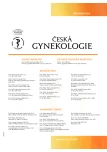The role of mesenchymal-epithelial transition in endometrial function and receptivity
Authors:
K. Crha 1; P. Ventruba 1; J. Žáková 1; M. Ješeta 1; R. Pilka 2; J. Vodička 2; P. Serpa 1
Authors‘ workplace:
Gynekologicko-porodnická klinika Lékařské fakulty Masarykovy univerzity a FN, Brno, přednosta prof. MUDr. P. Ventruba, DrSc., MBA
1; Porodnicko-gynekologická klinika FN a LF UP, Olomouc, přednosta prof. MUDr. R. Pilka, Ph. D.
2
Published in:
Ceska Gynekol 2019; 84(5): 371-375
Category:
Overview
Objective: During reproductive age of a woman, endometrium undergoes frequent stuctural and functional changes. Abilities of regeneration, remodelation and differentiation are precondition of endometrial receptivity and implantation and development of an embryo. These processes are conditioned by mutual transformation between mesenchymal and epithelial fenotype of endometrial cells: epithelial-mesenchymal transition (EMT) and mesenchymal-epithelial transition (MET). The aim of this study is to present contemporary knowledge of transformation between epithelial and mesenchymal endometrial cells and its influence on human fertility.
Design: Review article.
Setting: Department of Obstetrics and Gynecology, Faculty of Medicine, Masaryk university and University Hospital Brno; Department of Obstetrics and Gynecology, University Hospital Faculty of Medicine, Palacky University, Olomouc.
Methods: PubMed was searched for articles in English indexed until February 2019 with terms of „endometrial receptivity“, „embryo implantation“, „endometrial regeneration“, „mesenchymal-epithelial transition/transformation“.
Results: It has been proved, that mesenchymal stromal cells participate on regeneration of not only the endometrial stroma, but also of the epithelium. During endometrial decidualisation under influence of ovarian steroids, the MET is under way. Stromal fibroblasts gain the morfological and functional properties of epithelial cells. During implantaion of an embryo, the trofoblast interacts with decidualised endometrium. Epithelial cells transform into mesenchymal (EMT), which mediate the growth of trofoblast.
Conclusion: Mutual transformation between stromal and epithelial cells in essential for normal function of endometrium and implantation and development of an embryo.
Keywords:
endometrium – endometrial receptivity – embryo implantation – endometrial regeneration
Sources
1. Aplin, JD., Ruane, PT. Embryo-epithelium interactions during implantation at a glance. J Cell Sci, 2017, 130, p. 15–22.
2. Crha, I., Ventruba, P., Žáková, J., et al. Děložní mikrobiom jako faktor receptivity endometria. Čes Gynek, 2019, 84(1), p. 49–54.
3. Fitchett, JE., Hay, ED. Medial edge epithelium transforms to mesenchyme after embryonic palatal shelves fuse. Dev Biol, 1989, 131, p. 455–474.
4. Gellersen, B., Reimann, K., Samalecos, A., et al. Invasiveness of human endometrial stromal cells is promoted by decidualization and by trophoblast-derived signals. Hum Reprod, 2010, 25, p. 862–873.
5. Grewal, S., Carver, J., Ridley, AJ., et al. Human endometrial stromal cell rho GTPases have opposing roles in regulating focal adhesion turnover and embryo invasion in vitro. Biol Reprod, 2010, 83, p. 75–82.
6. Gupta, IR., Ryan, AK. Claudins: unlocking the code to tight junction function during embryogenesis and in disease. Clin Genet, 2010, 77, p. 314–325.
7. Hay, ED. Extracellular matrix, cell skeletons, and embryonic development. Am J Med Genet, 1989, 34, p.14–29.
8. Ješeta, M., Crha, T., Žáková, J., et al. Bisfenoly v patologii reprodukce. Čes Gynek, 2019, 84(2), p. 161–165.
9. Liang, J., Wang, S., Wang, Z. Role of microRNAs in embryo implantation. Reprod Biol Endocrinol, 2017, 15, p. 90.
10. Mullen, RD., Behringer, RR. Molecular genetics of müllerian duct formation, regression and differentiation. Sex Dev, 2014, 8, p. 281–296.
11. Nguyen, HPT., Xiao, L., Deane, JA., et al. N-cadherin identifies human endometrial epithelial progenitor cells by in vitro stem cell assays. Hum Reprod, 2017, 32, p. 2254–2268.
12. Nieto, MA., Huang, RY., Jackson, RA., et al. EMT: 2016. Cell, 2016, 166, p. 21–45.
13. Owusu-Akyaw, A., Krishnamoorthy, K., Laura, T. Goldsmith, LT., et al. The role of mesenchymal-epithelial transition in endometrial function. Hum Reprod Update, 2019, 25(1), p. 114–133.
14. Simón, C., Mercader, A., Garcia-Velasco, J., et al. Coculture of human embryos with autologous human endometrial epithelial cells in patients with implantation failure. J Clin Endocrinol Metab, 1999, 84, p. 2638–2646.
15. Thiery, JP., Acloque, H., Huang, RYJ., Nieto, MA. Epithelial-mesenchymal transitions in development and disease. Cell, 2009, 139, p. 871–890.
16. Ulrich, D., Tan, KS., Deane, J., et al. Mesenchymal stem/stromal cells in post-menopausal endometrium. Hum Reprod, 2014, 29, p. 1895–1905.
17. Ventruba, P., Žáková, J., Ješeta, M., et al. Současná témata reprodukční medicíny v České republice. Čes Gynek, 2016, 81(3), p. 234–240.
18. Vodička, J., Dvořan, M., Smékalová, K., et al. Možnosti přípravy endometria ke kryotransferu. Čes Gynek, 2018, 83(1), p. 24–28.
19. Yang, J., Weinberg, RA. Epithelial-mesenchymal transition: at the crossroads of development and tumor metastasis. Dev Cell, 2008, 14, p. 818–829.
20. Yu, L., Hu, R., Sullivan, C., et al. MFGE8 regulates TGF-β-induced epithelial mesenchymal transition in endometrial epithelial cells in vitro. Reproduction, 2016, 152, p. 225–233.
21. Zhang, XH., Liang, X., Liang, XH., et al. The mesenchymal-epithelial transition during in vitro decidualization. Reprod Sci, 2013, p. 354–360.
22. Zhang, Q., Yan, J. Update of Wnt signaling in implantation and decidualization. Reprod Med Biol, 2016, 15, p. 95–105.
Labels
Paediatric gynaecology Gynaecology and obstetrics Reproduction medicineArticle was published in
Czech Gynaecology

2019 Issue 5
Most read in this issue
- Syndrome Mayer-Rokitansky-Küster-Hauser – uterine and vaginal agenesis: current knowledge and therapeutic options
- ERAS protocol in gynecologic oncology
- First-trimester screening for preeclampsia
- Uterine rupture during pregnancy
